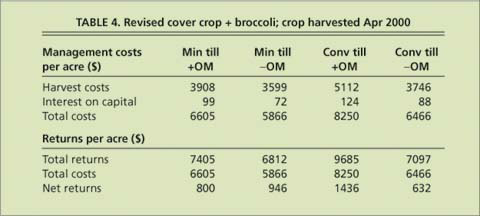All Issues
Economic analysis clarified
Publication Information
California Agriculture 57(3):68-68.
Published July 01, 2003
PDF | Citation | Permissions
Full text
California Agriculture received the following clarification from author Louise Jackson concerning "Scientists, growers assess trade-offs in use of tillage, cover crops and compost" (note correct title)(April-June 2003, p. 48-54):
In the economic analysis of Salinas Valley cropping systems that differed in tillage and organic matter management, a spreadsheet error occurred in the calculation of broccoli yields used in table 4 and figure 5. Although broccoli in the conventional tillage plus organic amendment (+OM; such as cover crops and compost) treatment still has the highest harvest costs, total costs, total returns and net returns (see table), the values are not as high as presented originally. The values for the three other treatments also increase because the harvest costs were calculated as a proportion of total harvest costs. However, the relative ranking of the treatments remains the same as originally presented.
Conventional tillage +OM is still the most profitable treatment for broccoli even though it was not the most profitable treatment for the lettuce crops in the experiment, possibly because broccoli is more responsive than lettuce to changes in surface soil characteristics. Tillage and organic matter management may be best tailored for responses of specific crops.
The total costs, returns and net returns for the 2-year period have changed due to the changes in broccoli performance (fig. 5). Revised total costs are: conventional tillage +OM ($31,548), conventional tillage −OM ($28,731/acre), minimum tillage +OM ($28,515) and minimum tillage −OM ($26,874). The ranking of net returns has changed as follows: minimum tillage −OM ($2,778/acre), conventional tillage −OM ($2,282/acre), conventional tillage +OM ($2,190) and minimum tillage +OM ($2,018). Conventional tillage +OM is not the most profitable across the four-crop rotation used during the 2-year period.
Our final conclusion remains the same: conventional tillage +OM with intermittent use of minimum tillage (e.g., between summer crops or to incorporate a cover crop) is the most viable option for enhancing various aspects of soil quality, avoiding the low productivity that was characteristic of long-term minimum tillage, and offering some reduction in tillage and fuel costs.
WHAT DO YOU THINK? The editorial staff of California Agriculture welcomes your letters, comments and suggestions. Please write to us at calag@ucop.edu or 1111 Franklin St., 6th floor, Oakland, CA 94607. Include your full name and address. Letters may be edited for space and clarity.





